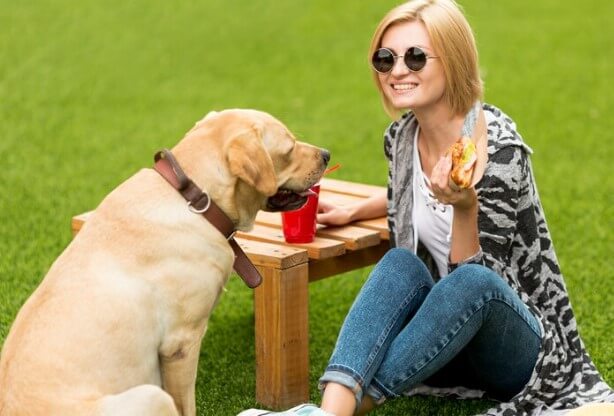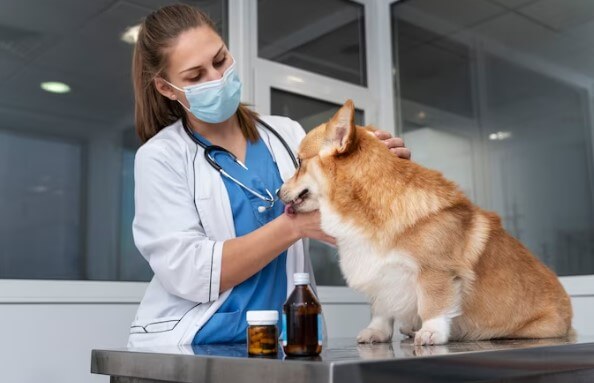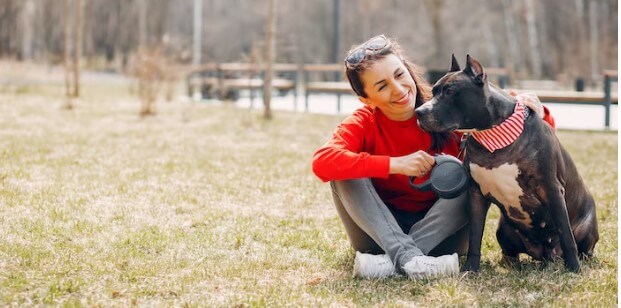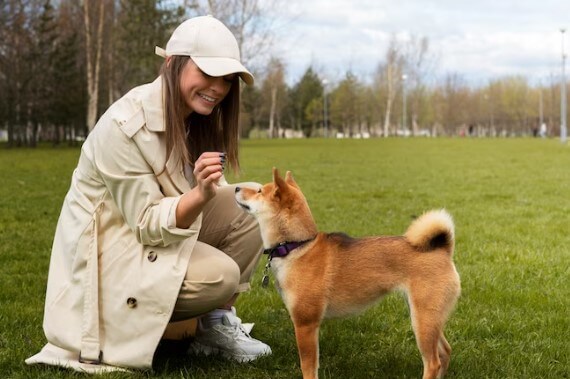If a dog tastes blood, it may have a tendency to attack again. Understanding this behavior is crucial for dog owners to prevent potential aggression.
If A Dog Tastes Blood Will It Attack Again
Dogs are remarkable creatures with complex behaviors, and their reactions can vary based on numerous factors.
If a dog tastes blood during an aggressive incident, it does not necessarily guarantee future attacks.
While some dogs may display more aggressive tendencies after such an experience, it doesn’t apply to all.
A dog’s temperament, training, and socialization play crucial roles in determining its behavior.
Responsible pet owners must promptly address aggressive behavior, seeking professional guidance if necessary.
Early intervention, positive reinforcement training, and a loving environment can help mitigate any potential escalation.
Remember, understanding and addressing a dog’s needs are the keys to fostering a safe and harmonious human-canine relationship.
Understanding Canine Aggression
Dogs are loving and loyal companions, but sometimes aggression can become a concern. Understanding what triggers aggression in dogs is crucial for responsible pet ownership. In this section, we will delve into the nature of canine aggression and explore the various factors that influence it.
By gaining insight into these factors, we can take proactive measures to prevent aggressive behaviors and ensure the safety of both our pets and others.
The Nature Of Canine Aggression: An Overview
- Aggression in dogs is a complex behavior that can arise due to a variety of factors.
- It is important to remember that not all aggression is the same, and different dogs may exhibit aggression in different ways.
- Aggressive behaviors can range from growling, barking, and lunging to biting and attacking.
- Dogs may display aggression out of fear, territoriality, resource guarding, or even as a response to pain or illness.
Factors Influencing Canine Aggression: Unraveling The Causes
Understanding the underlying causes of aggression is essential in addressing and managing this behavior effectively. Let’s explore some of the key factors that can contribute to canine aggression:
Genetics And Breed Predispositions
- Certain dog breeds are known to have genetic predispositions to aggressive behaviors.
- Breeds such as pit bulls, Rottweilers, and Doberman pinschers, for example, may have a higher tendency towards aggression.
- However, it is important to note that genetics alone do not determine a dog’s behavior, and proper socialization and training play a crucial role.
Socialization And Training
- Proper socialization during a dog’s developmental stages is vital in preventing aggressive behaviors.
- Early exposure to a variety of people, animals, and environments helps dogs become more confident and less reactive.
- Adequate training, based on positive reinforcement methods, helps dogs understand appropriate behaviors and develop good manners.
Environmental Factors
- The environment in which a dog grows and lives can significantly impact its behavior.
- Dogs kept in stressful, abusive, or neglectful environments are more likely to exhibit aggression.
- Lack of mental and physical stimulation, overcrowding, and poor socialization opportunities can also contribute to aggressive behaviors.
Medical Conditions And Pain
- Undiagnosed medical conditions or chronic pain can cause dogs to become aggressive.
- Pain can make a dog more irritable and reactive, leading to aggressive outbursts.
- Regular veterinary check-ups and prompt attention to any signs of discomfort can help prevent aggression related to medical conditions.
Understanding the nature of canine aggression and the various factors that influence it is the first step towards addressing and managing this behavior.

By taking a proactive approach through proper socialization, training, and providing a safe and nurturing environment, we can foster a well-balanced and non-aggressive canine companion.
Remember, a well-behaved dog is not only a joy to be around but also contributes to a safe and harmonious community.
The Science Behind Reactive Aggression
Reactive aggression, also known as impulsive aggression, is a complex behavior exhibited by dogs when they respond aggressively in specific situations. Understanding the underlying science behind reactive aggression can shed light on the factors that contribute to this behavior.
This article explores the science behind reactive aggression in dogs, focusing on the fight or flight response and the neurological and hormonal mechanisms involved.
Reactive Aggression Explained: The Fight Or Flight Response
- When faced with a perceived threat, dogs can exhibit reactive aggression as a defense mechanism. This behavior is triggered by their natural fight or flight response, which is deeply ingrained in their evolutionary history.
- The fight or flight response is a survival instinct that helps animals, including dogs, protect themselves in potentially dangerous situations. When confronted with a perceived threat, a dog can either choose to confront the threat (fight) or seek safety by escaping or avoiding the situation altogether (flight).
- Reactive aggression occurs when a dog interprets a situation as threatening and feels the need to defend itself. This response can be triggered by various stimuli, including the presence of unfamiliar people or animals, territorial disputes, or feeling threatened or cornered.
- It’s important to note that reactive aggression is not synonymous with aggression rooted in dominance or fear. Reactive aggression is more impulsive and is driven by the immediate need to protect oneself, rather than asserting dominance or acting out of fear.
Neurological And Hormonal Factors
- Reactive aggression involves a complex interplay of neurological and hormonal factors, which contribute to a dog’s propensity to respond aggressively in certain situations.
- Neurologically, reactive aggression is influenced by brain regions responsible for processing emotions and threat detection, such as the amygdala and prefrontal cortex. An imbalance or dysfunction in these areas can affect a dog’s ability to regulate their response to perceived threats, leading to reactive aggression.
- Hormonal factors also play a role in reactive aggression. The release of stress hormones, such as adrenaline and cortisol, during a perceived threat can heighten a dog’s arousal and fuel their aggressive response. Additionally, sex hormones, such as testosterone, can influence a dog’s predisposition to reactive aggression.
- It’s worth mentioning that genetics and early life experiences can shape a dog’s neurological and hormonal responses, influencing their propensity for reactive aggression. Certain breeds may have a higher predisposition to reactive aggression due to their genetic makeup and selective breeding.
Understanding the science behind reactive aggression in dogs provides valuable insights into its triggers and mechanisms.
By recognizing the fight or flight response and the neurological and hormonal factors involved, dog owners and trainers can better manage and mitigate reactive aggression in their furry companions.
The Role Of Past Experiences
Dogs are fascinating creatures that can bring so much joy and companionship to our lives.
However, understanding their behavior and what drives them is essential for responsible pet ownership. One question that often arises is whether a dog that has tasted blood will attack again.
This blog post will explore the role of past experiences in canine aggression and delve into the concept of post-traumatic aggression.
By examining real-life case studies and understanding the impact of traumatic incidents, we can gain valuable insights into this intriguing topic.
Learning From Past Encounters: Canine Aggression Case Studies
- Case study 1: In a controlled experiment, a dog was trained to attack a target and rewarded with blood-scented objects. The dog eventually started displaying aggression towards people and other animals, suggesting that past experiences may contribute to future aggressive behavior.
- Case study 2: A rescue dog with a history of abuse showed initial signs of aggression, but with positive reinforcement training and a loving environment, the dog gradually learned to trust humans again and became non-aggressive.
- Case study 3: A previously docile dog was involved in a violent fight with another canine. After this traumatic incident, the dog developed aggressive tendencies towards other dogs, highlighting the lasting impact of negative experiences.
The Impact Of Traumatic Incidents: Post-Traumatic Aggression
- Traumatic incidents, such as attacks from other animals or abuse from humans, can significantly impact a dog’s behavior and temperament.
- Post-traumatic aggression is a phenomenon where a previously non-aggressive dog becomes aggressive following a traumatic event. This aggression is often a result of fear, anxiety, or a defensive response.
- Dogs experiencing post-traumatic aggression may display reactive behaviors, such as growling, lunging, or biting, as a way to protect themselves from perceived threats.
- It is crucial to understand that post-traumatic aggression can be managed and treated through proper training, behavior modification techniques, and, in some cases, professional support from a certified animal behaviorist.
Understanding the role of past experiences and the possible impact of traumatic incidents on a dog’s behavior is crucial for both pet owners and those working with dogs professionally.
By recognizing the signs and addressing aggressive tendencies early on, we can promote a safe and harmonious environment for our canine companions.
Stay tuned for the following sections in this blog post as we dive deeper into effective strategies for managing and mitigating canine aggression.
Understanding The Significance Of Blood
Dogs are known for their keen senses and natural instincts. One of the most powerful instincts in dogs is their prey drive, which can be triggered by various factors.
One such factor is the presence of blood. Understanding the significance of blood in relation to a dog’s behavior is crucial for dog owners and enthusiasts.

In this section, we will explore the sensation of blood and how it can trigger a dog’s prey drive. We will also discuss the difference between hunting and prey drive in domesticated dogs.
The Sensation Of Blood: Triggering The Prey Drive
- When a dog tastes blood, it can elicit a primal sensation that triggers their prey drive. This drive is deeply rooted in their evolutionary instincts as descendants of wild predators.
- The metallic scent and taste of blood can activate a dog’s olfactory senses, making it highly arousing and captivating for them.
- Dogs have a highly developed ability to detect even small traces of blood, and this discovery can intensify their focus and determination.
- The presence of blood can fuel a dog’s predatory instincts and prompt them to exhibit behaviors associated with hunting, such as stalking, chasing, and biting.
- It’s important to note that not all dogs will have the same response to the sensation of blood. Factors such as breed, individual temperament, and prior training can influence their reaction.
Instinctual Responses: Hunting Vs. Prey Drive In Domesticated Dogs
- Hunting behavior in domesticated dogs is different from their prey drive. Hunting refers to the act of pursuing and catching prey for survival or sport, while prey drive is an instinctive response triggered by certain stimuli.
- Prey drive is present in varying degrees in different breeds and individual dogs. Some dogs may have a high prey drive, while others may have a lower drive and may require additional training to exhibit hunting behaviors.
- Domesticated dogs with a high prey drive may display certain behaviors when they encounter the sensation of blood. These can include increased alertness, heightened focus, intense curiosity, and an eagerness to investigate the source of the blood.
- It’s important for dog owners to be aware of their dog’s prey drive and how it may manifest in different situations. Proper training and management are essential to ensure the safety of both the dog and those around them.
- Understanding the significance of blood in relation to a dog’s prey drive is crucial for dog owners, as it can help them anticipate and manage their dog’s behavior in relevant situations.
Remember, it is essential to consult with a professional dog trainer or behaviorist for guidance specific to your dog if you have concerns about their response to the sensation of blood.
Canine Aggression And Territoriality
Protecting What’s Mine: Uncovering Territorial Aggression
Dogs are known for their loyalty and protective nature, especially when it comes to their territory. Understanding canine aggression and territoriality is crucial for dog owners and those who interact with dogs regularly.
In this section, we will delve into the fascinating world of territorial aggression and how it can influence a dog’s behavior.
The Influence Of Ownership And Fences On Aggressive Behaviors
Territorial aggression in dogs can be influenced by various factors, including ownership and the presence of physical boundaries such as fences. Here are some key points to consider:
- Ownership: Dogs are instinctively protective of their owners and their property. When they sense a threat or intrusion, they can exhibit aggressive behaviors to defend what they perceive as theirs. Understanding this instinctual drive can help owners anticipate and manage their dog’s territorial aggression effectively.
- Fences as boundaries: Physical boundaries, such as fences, can play a significant role in a dog’s territorial behavior. Fences provide a clear demarcation of the dog’s territory, creating a sense of ownership and control. They can act as a deterrent to potential intruders and help minimize aggressive responses. However, it’s important to note that fences are not foolproof, and dogs may still display territorial aggression even with the presence of physical boundaries.
- Training and socialization: Proper training and socialization are vital in managing territorial aggression. By exposing dogs to various environments, people, and animals, owners can help them develop a more balanced response to perceived threats. Positive reinforcement training techniques can also be employed to teach dogs appropriate behaviors and redirect their aggressive tendencies.
- Environmental factors: Environmental factors, such as noisy surroundings or frequent disruptions near the dog’s territory, can exacerbate territorial aggression. Dogs may feel threatened by these disturbances and resort to aggressive behaviors as a defense mechanism. Identifying and addressing these environmental triggers can help in managing and preventing territorial aggression.
- Seeking professional help: If a dog’s territorial aggression becomes problematic or uncontrollable, seeking professional help from a certified dog behaviorist or trainer is recommended. These experts can assess the situation, develop a tailored behavior modification plan, and provide guidance on effective ways to manage and reduce territorial aggression.
Understanding the complex interplay between ownership, physical boundaries, training, and environmental factors is instrumental in dealing with territorial aggression in dogs.
By employing appropriate strategies and seeking professional assistance when needed, owners can ensure a safe and harmonious environment for both their dog and those around them.
Provoking Dog Aggression: The Role Of Fear
Dogs are known for their loyalty, playfulness, and affection towards their owners.
However, there are instances when a dog may display aggression, causing concern for their owners. One question that often arises is whether a dog that has tasted blood will attack again.
The answer to this question is multifaceted, as it depends on various factors including the root cause of the aggression.
In this blog post, we will explore the role of fear in provoking dog aggression and how to address this underlying issue.
Fear-Based Aggression: Addressing The Root Cause
- Fear is one of the primary causes of aggression in dogs. When a dog feels threatened or scared, it may resort to aggressive behavior as a defense mechanism.
- Understanding the root cause of the dog’s fear is crucial in addressing fear-based aggression. It is recommended to consult with a professional dog trainer or behaviorist who can assess the situation and provide guidance.
- Addressing the underlying fear requires a patient and gradual approach. It is essential to create a safe and supportive environment for the dog to help them overcome their fears.
- Training techniques such as desensitization and counterconditioning can be beneficial in helping the dog develop a positive association with their triggers.
- Seeking professional help is important, as using improper techniques or not addressing the root cause of fear-based aggression can potentially escalate the problem.
Recognizing Fearful Body Language: Signals To Look For
- Dogs often display specific body language signals when they are fearful or anxious. Recognizing these signals can help owners intervene before the aggression escalates.
- Some common signs of fear in dogs include flattened ears, tucked tail, lowered body posture, dilated pupils, and trembling.
- Lip licking, yawning, and panting excessively can also be indicators of a dog experiencing distress.
- It is crucial to observe the context in which these behaviors are exhibited, as they can be subtle and easily missed.
- Properly identifying these signals can help owners take appropriate action, such as removing the dog from the triggering situation or providing them with a safe space to calm down.
By addressing fear-based aggression and recognizing fearful body language, dog owners can take proactive steps to reduce the risk of future incidents.
Creating a safe and supportive environment for dogs allows them to overcome their fears and leads to a happier and healthier relationship between the dog and their owner.
Remember, seeking professional guidance is always recommended to properly address fear-based aggression in dogs.
Preventing Aggression: Training And Socialization
Dogs are known for their loyalty, companionship, and love. However, there may be situations where a dog displays aggression, and it’s crucial to understand how to prevent it. One common concern is whether a dog that has tasted blood will attack again.
Preventing aggression through effective training and socialization plays a vital role in shaping a dog’s behavior and ensuring their overall well-being.
Let’s explore the importance of early training and socialization, as well as the power of positive reinforcement in shaping desired behaviors.
The Vital Role Of Early Training And Socialization
- Early training and socialization are crucial for dogs to develop appropriate behavior patterns from a young age.
- A well-socialized dog learns to interact positively with people, other animals, and various environments, reducing the likelihood of aggression.
- Socialization helps dogs become familiar with different situations, sounds, and stimuli, preventing fear-based aggression.
- Effective training techniques help establish boundaries, teach basic obedience commands, and reinforce good behavior.
- Training sessions should be consistent, with positive reinforcement used to encourage desired behaviors.
- Exposing dogs to various environments, people, and animals during early stages of training helps build confidence and reduce anxiety.
Positive Reinforcement: Shaping Desired Behaviors
- Positive reinforcement involves rewarding a dog for exhibiting desired behaviors, rather than punishing for unwanted actions.
- Rewards can include treats, praise, playtime, or anything the dog finds motivating and enjoyable.
- Reinforcing desired behaviors strengthens the dog’s association between the action and the positive consequence, increasing the likelihood of repetition.
- Consistent use of positive reinforcement helps shape a dog’s behavior over time, encouraging them to make positive choices.
- It is important to use rewards immediately after the desired behavior occurs to reinforce the connection and build a positive association.
By focusing on early training and socialization and using positive reinforcement techniques, dog owners can play an active role in preventing aggression.
With consistency, patience, and love, dogs can learn appropriate behaviors, become well-adjusted members of our families, and avoid future aggressive tendencies.

Remember, every dog is unique, and tailoring training methods to their individual needs is essential. So let’s embark on this training journey with our furry friends, ensuring their happiness and safety every step of the way.
Correcting Aggression: Behavioral Modification Strategies
Aggressive behavior in dogs can be a concerning issue for pet owners. If your dog has tasted blood and exhibited aggressive tendencies, it’s vital to address this behavior promptly and effectively. Fortunately, there are behavioral modification strategies that can help correct aggression in dogs.
This section will focus on two key approaches: seeking professional help from dog trainers and behaviorists, and implementing counterconditioning and desensitization techniques.
Seeking Professional Help: Dog Trainers And Behaviorists
Professional assistance can play a crucial role in addressing and resolving aggression issues in dogs. Here are some key points to consider when seeking professional help:
- Expertise and experience: Dog trainers and behaviorists are trained professionals who specialize in working with aggressive dogs. They have the knowledge and expertise to assess and understand the underlying causes of aggression, as well as the appropriate techniques to modify behavior.
- Individualized approach: A professional will assess your dog’s specific aggression issues and develop a tailored plan to address them. They will consider factors such as the dog’s breed, temperament, and past experiences.
- Training techniques: Trainers and behaviorists utilize positive reinforcement methods to teach dogs alternative, non-aggressive behaviors. Through reward-based training, dogs learn to associate positive experiences with desired behaviors, which can help override aggressive tendencies.
- Ongoing support: Professionals can provide ongoing support and guidance throughout the behavior modification process. They can monitor progress, make necessary adjustments to the training plan, and offer advice to pet owners.
Counterconditioning And Desensitization: Reversing Aggressive Behaviors
Counterconditioning and desensitization are crucial techniques used to reverse aggressive behaviors in dogs. Here’s what you need to know:
- Counterconditioning: This technique involves replacing the dog’s aggressive response with a positive or neutral behavior. It aims to change the dog’s emotional response to a specific trigger by associating it with something pleasant or rewarding.
- Desensitization: Desensitization is a gradual process of exposing the dog to the stimulus that triggers aggressive behavior, starting with a very low intensity and gradually increasing it over time. The goal is to reduce the dog’s sensitivity and fearfulness towards the trigger.
- Consistency and patience: Both counterconditioning and desensitization require consistency and patience from the dog owner. It’s important to follow the prescribed training plan consistently and provide rewards or positive reinforcement when the dog displays non-aggressive behaviors.
- Professional guidance: While counterconditioning and desensitization can be implemented by pet owners, seeking guidance from a professional is recommended to ensure proper techniques and progress monitoring.
By enlisting the help of professional trainers or behaviorists and applying counterconditioning and desensitization techniques, you can effectively address and correct aggressive behaviors in your dog. Remember, consistency, patience, and ongoing support are key in the journey to behavioral modification.
Exploring Different Types Of Aggressive Behavior
If a dog tastes blood, it’s natural to wonder if it will attack again. Understanding the different types of aggressive behavior in dogs is important for both dog owners and those who come into contact with dogs regularly. In this section, we will explore two specific types of aggressive behavior: dominance aggression and resource guarding.
These behaviors can give us insights into why dogs may become aggressive and how we can prevent or manage such behavior.
Dominance Aggression: Debunking Misconceptions
- Dominance aggression is often misunderstood as a result of a dog wanting to be the “alpha” or dominant in the household. However, experts now have a more nuanced understanding of dominance aggression.
- Dogs displaying dominance aggression may exhibit behaviors such as growling, snapping, or even biting when they feel their status is being challenged.
- It’s important to note that dominance aggression is not a breed-specific issue and can occur in any breed or mix.
- Dominance aggression can be triggered by various factors, including improper socialization, lack of clear leadership, or inconsistent rules and boundaries.
- Training and consistent reinforcement of positive behaviors are crucial in managing dominance aggression. Seeking professional help from a certified dog behaviorist is highly recommended for addressing this aggression effectively.
Resource Guarding: Understanding Possessiveness
- Resource guarding refers to a dog’s tendency to become possessive and protective over valued items or spaces, such as food, toys, or resting areas.
- Dogs displaying resource guarding behavior may growl, snarl, or even bite when they perceive a threat to their resources.
- Resource guarding can be a result of innate instincts or learned behavior.
- This behavior can pose a risk to both humans and other animals, especially in situations where the dog’s guarded resource is being approached or taken away.
- Early intervention, through proper training and behavior modification techniques, is crucial to manage resource guarding effectively.
- Consulting with a professional dog trainer or behaviorist who specializes in resource guarding can provide valuable guidance in dealing with this type of aggression.
Understanding the different types of aggressive behavior in dogs, such as dominance aggression and resource guarding, can help us address and prevent potential issues.
By seeking professional training, implementing consistent rules and boundaries, and focusing on positive reinforcement, we can create a safer and more harmonious environment for both dogs and humans alike.
Remember, every dog is unique, and behavior issues should always be addressed with patience, understanding, and proper guidance.
Frequently Asked Questions
Can A Dog Become Aggressive After Tasting Blood?
Some dogs may exhibit aggressive behavior after tasting blood because it triggers their predatory instincts. It is important to monitor their behavior and seek professional help if your dog shows signs of aggression.
Are All Dogs Prone To Attacking Again If They Taste Blood?
Not all dogs will attack again if they taste blood. Each dog has a unique temperament and reactions. Some may become more aggressive, while others may not exhibit any change in behavior.
What Should I Do If My Dog Attacks Another Animal Or Person?
If your dog attacks another animal or person, it is essential to seek immediate medical attention if necessary and consult with a professional dog behaviorist or trainer to address the underlying issue causing the aggression.
Can Training Prevent A Dog From Attacking After Tasting Blood?
Effective training and appropriate socialization can help prevent or manage aggressive behavior in dogs, even after they have tasted blood. Consistent training, positive reinforcement, and seeking professional guidance can make a significant difference.
How Can I Ensure The Safety Of Others If My Dog Tastes Blood?
To ensure the safety of others, it is essential to take immediate action. Secure your dog in a safe area away from potential victims and contact a professional dog behaviorist or trainer to evaluate and address the underlying causes of aggression.

Conclusion
It is important to understand that if a dog tastes blood, it does not necessarily mean that it will attack again. While some dogs may exhibit aggressive behavior after experiencing the taste of blood, it is not a universal response.
Factors such as breed, temperament, training, and individual circumstances can greatly influence a dog’s behavior.
It is crucial for dog owners to be aware of their pet’s actions and seek professional guidance if they notice any concerning behaviors. Proper training, socialization, and responsible ownership can play a significant role in preventing aggressive tendencies in dogs.
Ultimately, it is essential to approach this topic with caution and not make broad generalizations about a dog’s behavior based solely on the taste of blood.
Every dog is unique, and understanding their individual needs and behaviors is key to nurturing a safe and harmonious bond between dogs and their owners.
Other Post:
How To Massage A Dog With Torn ACL
Can Dogs Eat Consume Guinea Pig Food
Do Dogs Get Cold In Air Conditioning During The Da
- Smelly House Because of Dog? Take These Hygiene Tips - May 20, 2025
- How to Introduce a Dog To a Cats Without Chaos - May 6, 2025
- 4 Best Cavapoo Rescues in the UK 2024 - April 5, 2024








